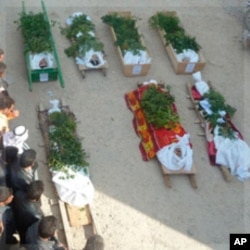Syria's third-largest city of Homs has paid a heavy price as one of the centers of the country's eight-month old opposition uprising.
Rights activists say Syrian security forces have killed more than 1,100 civilians in the city and its surrounding province since the uprising began, more than any other part of the country. Experts say the unrest has escalated in Homs because of the region's poverty, its role as a natural home for army defectors and its history of anti-government protest.
History of Homs
Homs has a history of opposition to Syria's ruling Baath party that goes back to the 1960s, when Baathists took power in a coup. Business owners and religious conservatives in Homs organized protests in 1964 against the Baath party's socialist and secular agenda. But Syria's Baath-led government ordered security forces to suppress the uprising, keeping the city quiet for decades.
|
Steven Heydemann discusses Sunni protesters:
|
Steven Heydemann, a senior adviser for Middle East initiatives at the U.S. Institute of Peace, says resentment of Baath rule in Homs persists.
"What we're seeing in some respects is the revival of an ethos of protest and resistance to the Baath government that anyone familiar with Homs would recognize from its past, but which is really taking very new forms and reflects very contemporary grievances," he said.
|
A Look At Syria's Main Opposition Groups
|
Among the new grievances fueling this year's uprising in Homs are poverty and government corruption, says Mousab Azzawi of the Syrian Observatory for Human Rights, an opposition group.
The Britain-based activist says anti-government sentiment is strong in the city's Baba Amr district, which has seen months of peaceful street protests against the 11-year rule of President Bashar al-Assad.
"Baba Amr, as the oldest and poorest part of Homs, was severely affected," he said. "The people there are very poor and very vulnerable, they feel that this regime put them so badly below the edge of poverty. So they are the real powers that are moving the acts of uprising in Homs."
Hub of defectors
Homs and the surrounding province also have become a hub for thousands of army deserters who have refused orders to attack the protesters. Rights activists say Homs is a natural refuge for the defectors because many of them are from the province, the nation's largest.
Syria's government blames the violence in Homs and other protest hubs on troublemakers. It says religious extremists from the Sunni majority are terrorizing minority Alawites and Christians and attacking security forces.
Homs is about 40 percent Sunni, 30 percent Alawite and 30 percent Christian. Syria's Alawite-dominated leadership says it is trying to protect minorities by cracking down on the extremists.
But Heydemann says there is little evidence of Sunni protesters in Homs pursuing an extremist ideology or organizing sectarian attacks. Heydemann sees the Syrian government as exaggerating an Islamist threat to try to divide and weaken the opposition movement.
Exiled Syrian dissidents say the government also is trying to incite sectarian violence in Homs by recruiting Alawite mercenaries.
Ausama Monajed, a London-based member of Syria's main opposition coalition, the Syrian National Council, says community leaders have formed committees to counter the violence.
|
Ausama Monajed speaks about violence in Homs:
|
"When the notable people from both sides discuss the issue, they realize neither Sunnis did this, nor the Alawites or the Christians," he said.
Free Syrian Army
Opposition activists in Homs are counting on an important ally - military defectors who formed the Free Syrian Army - to defend civilians.
The Free Syrian Army has fought increasingly deadly battles with pro-Assad troops in and around Homs in recent weeks. Dissidents say the defectors also have formed protective lines around protests and urged demonstrators to remain peaceful.
But Heydemann says army defectors and protest leaders are not yet united.
"There tend to be divisions between them about which tactics are most effective in the long run," he said. "And there are peaceful protesters who are actually disturbed by the increasing use of force by groups opposed to the government."













